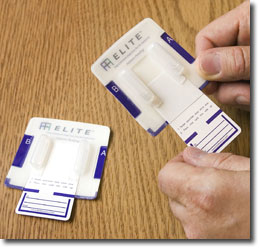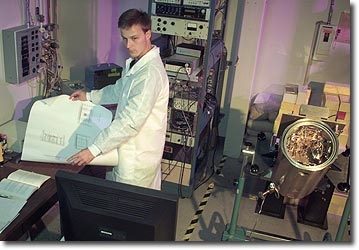Laboratory captures seven R&D 100 awards for industrial innovations
LIVERMORE, Calif. — Lawrence Livermore National Laboratory researchers have captured seven awards for developing advanced technologies with commercial potential.
Six teams of LLNL scientists and engineers and an individual LLNL researcher have won plaques from the trade journal R&D Magazine for being among the top 100 industrial innovations worldwide for 2005. They worked with three industrial collaborators and a university space sciences laboratory.
Often dubbed the "Oscars of invention," this year’s R&D 100 awards will be presented Oct. 19 during a black-tie dinner in the Grand Ballroom of Chicago’s Navy Pier.
"LLNL’s seven R&D 100 awards demonstrate the Laboratory continues to be a source of creative technologies that benefit the nation and U.S. industry," said Cherry Murray, LLNL’s deputy director for Science and Technology. "These advances reflect the Laboratory’s tradition of using multidisciplinary teams working together to solve important national problems."
For this year, the Laboratory garnered more R&D 100 awards than any other institution, tying its previous record number of seven (also achieved in 1987, 1988, 1997 and 1998).
With this year’s awards, the Laboratory has captured a total of 113 such awards since 1978. Department of Energy (DOE) labs received a total of 41 R&D 100 awards in this year’s judging.
"I congratulate the researchers who have won these awards, which highlight the power and promise of DOE’s investments in science and technology," said Secretary of Energy Samuel Bodman. "Through the efforts of dedicated and innovative scientists and engineers at our national laboratories, DOE is helping to enhance our nation’s energy, economic and national security."
Three of this year’s LLNL award-winning technologies could prove helpful in homeland security, with one advance for explosives detection, another for radiation detection, and the last, a surveillance system that could find use in border security.
Rapidly detecting explosives
Airport screeners, military personnel and others have a new ally in the war against terrorism – a portable, sensitive and accurate explosives detector developed by researchers at LLNL’s Forensic Science Center.
Called the Easy Livermore Inspection Test for Explosives, or ELITE, the new explosives detector is highly sensitive to more than 30 different explosives, making it one of the most effective explosive detection systems available.
The technology, which can detect explosives within one to four minutes, has been licensed to Field Forensics Inc., a St. Petersburg, Fla. company. It went on the market last October.
Already, Field Forensics Inc. has picked up a host of customers, including the U.S. Army, the Royal Canadian Mounted Police, the Ontario Provincial Police, the Canada Air Marshals, the Queensland Police from Australia and others.
The ELITE technology is light (weighing a fraction of an ounce), small (the size of a 2-inch by 3-inch index card), inexpensive (costing less than $25, and substantially less in higher quantities) and stable (with a shelf life of about two years).
A new radiation detector
Researchers in the Laboratory’s Radiation Detection Center have developed a new high-precision radiation detector called UltraSpec that operates at very low temperatures, and could assist security officials in identifying even small amounts of nuclear materials.
Developed in conjunction with VeriCold Technologies GmbH, a company based in Ismaning, Germany, UltraSpec offers comparable precision to mass spectrometers for quantifying material composition, yet its operation also is automated so that non-specialists can operate it with the push of a button.
Lab researchers created the instrument’s sensor and first prototype spectrometer, while VeriCold Technologies developed the cooling system for commercialization. Unlike the cooling systems for many other high-precision detection systems that use liquid nitrogen, the UltraSpec system is mechanically cooled, reducing the need for frequent maintenance to replace the coolant.
UltraSpec is unique in its ability to detect either gamma rays, which are emitted by all nuclear material, or neutrons. As a gamma-ray spectrometer, it provides an energy resolution that is 10 times better than conventional instruments. There also are many situations in which high-resolution neutron detection is desirable.
For example, if a light element such as oxygen were bound to a nuclear isotope, a gamma-ray spectrometer would not be able to detect it because oxygen doesn't emit gamma rays. However, when configured as a neutron detector, UltraSpec can detect and measure the amount of oxygen or other light elements that may be bound to a nuclear material.
This capability is not only important for identifying illicit sources of nuclear material, but also for ensuring the safety of stored nuclear material at nuclear power plants, weapons stockpiles and waste facilities.
Surveillance system shift
Lab physicists and engineers have created the Sonoma Persistent Surveillance System, which offers the first integrated, broad-area, high-resolution, real-time motion imagery system for surveillance applications.
Sonoma is unique in its ability to provide continuous, real-time video imagery of an area the size of a small city with resolutions sufficient to track up to 8,000 moving objects within the field of view.
The Sonoma system was designed to provide real-time data for actionable information in situations such as monitoring traffic, special events, border security and harbors.
During the past year, Lab officials have received a number of inquiries about technology transfer and the commercialization of the Sonoma system and technologies. Sonoma is expected to cost about one-tenth the price of comparably sized sensor systems.
Changing the ‘color’ of laser light
LLNL laser scientists have developed a high-average-power wavelength conversion device that can change the "color" of laser light, permitting large-aperture high-average-power lasers to operate at half the wavelength of the laser crystal’s natural emission wavelength.
The device, which uses an yttrium calcium oxyborate (YCOB) crystal, was developed in tandem with Crystal Photonics, Inc., a company based in Sanford, Fla.
Many of today’s lasers operate in the infrared portion of the spectrum – a color or wavelength that is not the most efficient for some applications. Both the YCOP crystal’s ability to handle heat and its ease of growing could permit some of these lasers to operate more efficiently at the shorter wavelength.
As examples, ceramics and plastics could be more efficiently machined with ultraviolet light, and copper metal for electronic circuit boards could be more efficiently cut with green light. The YCOB wavelength converter holds the current world record for an average-power, high-pulse-energy laser at 225 watts of 523.5 nanometer light, at a repetition rate of 10 hertz and 22.5 joules per pulse. One YCOB crystal can replace eight optical components.
Seeing planets better and more cheaply
An LLNL physicist, David Erskine, and Jerry Edelstein, an astronomer at the UC Berkeley Space Sciences Laboratory, have developed a technique called "Externally Dispersed Interferometry" (EDI) to conduct precision measurements of the Doppler velocities of stars or sunlit targets.
Using an interferometer-spectrograph system, the EDI technique already has been used by a University of Florida researcher to detect the planet around 51 Pegasi and also to discover a new planet in the constellation Virgo. This is the furthest planet discovered with the Doppler effect using a telescope of less than one meter in diameter.
The Doppler effect is a method for precisely measuring the velocities of stars – and the method works because a planet tugs on the star, causing it to wobble, a change that can then be measured.
Using a $14,000 interferometer, the EDI technique provides a threefold improvement in spectral resolution at a tiny fraction of the cost of a $4 million conventional grating spectrograph. The EDI system also is much smaller, weighing 50 pounds and about the size of a television set, compared with the conventional grating spectrograph, which weighs 16,000 pounds and is the size of a kitchen. It is believed that with EDI more universities and colleges that could otherwise not afford multi-million installations could now conduct precision Doppler measurements.
In conjunction with collaborators from Cornell University and UC Berkeley, Erskine has received a three-year grant from the National Science Foundation to search for planets around low-temperature stars in the infrared region. The work is under way at the Mount Palomar Observatory near San Diego.
Sapphire helps find useful data
One of the great challenges researchers face today is extracting the information they need from enormous data sets. A Laboratory team in the Center for Applied Scientific Computing (CASC) has developed analysis algorithms allowing the exploration of large, complex and multidimensional data sets. The technology has been dubbed Sapphire.
"Our ability to generate data far outstrips our ability to explore, analyze and understand it," said Chandrika Kamath, leader of the Sapphire project. "Data that was measured in gigabytes (billions of bits of information) until recently, now is being measured in terabytes (trillions of bytes), and will soon approach the petabyte (100,000 trillion bytes) range.
"Often, the data are complex, available either as time-series data, or as images. In order to achieve our scientific goals, we need to fully exploit this data by extracting all the useful information from it. This is the idea behind Sapphire," Kamath added.
By applying ideas from data mining, video processing, statistics and pattern recognition, Lab researchers are developing new computational tools and techniques that are used to extract useful information from huge data sets.
Sapphire technology is being applied to a variety of disciplines, including plasma physics experiments and simulations, remote sensing imagery, video surveillance, climate simulations, astronomy, and fluid mix experiments and simulations. The Lab team has six patents on Sapphire technology.
Bridging the programming language barrier
Much as people from different countries have difficulty communicating across linguistic barriers, computer scientists developing simulation codes face language incompatibilities among the software libraries they must use. Babel – pronounced "babble" – is an LLNL-developed tool that addresses this problem.
Babel is distinguished by its high-performance language interoperability, enabling cross language communication with minimal runtime overhead.
Scientific software libraries are written in a number of programming languages: Fortran, C, C++, or a scripting language such as Python. Language differences often force software developers to generate mediating "glue" code by hand, a time consuming process. In the worst case, computational scientists must rewrite a library from scratch or not use it at all.
Babel’s Scientific Interface Definition Language (SIDL) describes the calling interface (but not the implementation) of a particular software library. SIDL tools such as Babel use this interface description to generate glue code that allows a software library implemented in one supported language to be called from any other supported language.
Babel is radically changing the way scientists compute.
The scientists who use Babel, or Babel-based component models, are given the ability to cheaply integrate almost any library or third-party tool available into their scientific application. This immediately gives them access to a whole host of best-in-class technologies that were formerly too difficult or expensive to integrate. Babel also ends the old "language wars," as the best language for the job can be used for each component of the system.
Founded in 1952, Lawrence Livermore National Laboratory has a mission to ensure national security and apply science and technology to the important issues of our time. Lawrence Livermore National Laboratory is managed by the University of California for the U.S. Department of Energy’s National Nuclear Security Administration.
Contact
Stephen Wampler[email protected]
925-423-3107
Related Links
Screening tool to help detect explosives nets technology transfer award for LLNL researchers“Radiation Detection on the Front Lines”
Externally Dispersed Interferometry Web site
“Mining Date for Gems of Information”








